One More Reblog! Seriously, Hit Me Up By Friday, April 14th If You Have Strong Opinions About What I
One more reblog! Seriously, hit me up by Friday, April 14th if you have strong opinions about what I delve into next, research-wise. I’m ready to get back to it. You can tweet me (@HDandtheVoid) or comment here on tumblr maybe? I have anonymous on, no worries. :)

The first episode is here! I have never done this before and right now, I’m planning to put up a podcast every two weeks.
Below the cut is some elaboration on the episode itself, including my sources, music credits, a glossary, and a transcript (not an exact record of this episode, but it’s the script I was working with and it’s both conversational and also a little less rambling than what I actually said). I’m on Twitter now, too: @HDandtheVoid. I don’t know what I’ll put there yet except maybe fun little facts and, of course, notifications on when an episode goes up.
Let me know what you think of this episode, let me know what you think I should research next*, tell me a fun space fact… anything’s helpful at this point!
*(Move fast if you feel strongly about what I research next, though, cuz I have to get it done by April 24th—I don’t mention it in the podcast but this is me telling you now so I am held accountable; April 24th is the next podcast.)
Keep reading
More Posts from Fillthevoid-with-space and Others
Hahaha, right after I start out a podcast talking about how we’ll never poke the Sun, it turns out we’re sending a probe to do just that!
Solar System: Things to Know This Week
Mark your calendars for summer 2018: That’s when we’re launching a spacecraft to touch the sun.
In honor of our first-ever mission to the heart of the solar system, this week we’re delving into the life and times of this powerful yellow dwarf star.

1. Meet Parker
Parker Solar Probe, our first mission to go to the sun, is named after Eugene Parker, an American astrophysicist who first theorized that the sun constantly sends out a flow of particles and energy called the solar wind. This historic mission will explore one of the last regions of the solar system to be visited by a spacecraft and help scientists unlock answers to questions they’ve been pondering for more than five decades.

2. Extra SPF, Please
Parker Solar Probe will swoop within 4 million miles of the sun’s surface, facing heat and radiation like no spacecraft before it. The mission will provide new data on solar activity to help us better understand our home star and its activity - information that can improve forecasts of major space-weather events that could impact life on Earth.

3. Majorly Massive
The sun is the center of our solar system and makes up 99.8 percent of the mass of the entire solar system. If the sun were as tall as a typical front door, Earth would be about the size of a nickel.
4. Different Spin
Since the sun is not a solid body, different parts of the sun rotate at different rates. At the equator, the sun spins once about every 25 days, but at its poles the sun rotates once on its axis every 36 Earth days.

5. Can’t Stand on It
The sun is a star and a star doesn’t have a solid surface. Rather, it’s a ball of ionized gas 92.1% hydrogen (H2) and 7.8% helium (He) held together by its own gravity.
6. Center of Attention
The sun isn’t a planet, so it doesn’t have any moons. But, the sun is orbited by eight planets, at least five dwarf planets, tens of thousands of asteroids, and hundreds of thousands to trillions of comets and icy bodies.

7. It’s Hot in There
And we mean really, really hot. The temperature at the sun’s core is about 27 million degrees Fahrenheit. However, its atmosphere, the corona, can reach temperatures of 3 million degrees. (That’s as if it got hotter the farther away you got from a fire, instead of cooler!) Parker Solar Probe will help scientists solve the mystery of why the corona’s temperature is so much higher than the surface.

8. Travel Conditions
The sun influences the entire solar system, so studying it helps us better understand the space weather that our astronauts and spacecraft travel through.
9. Life on the Sun?
Better to admire from afar. Thanks to its hot, energetic mix of gases and plasma, the sun can’t be home to living things. However, we can thank the sun for making life on Earth possible by providing the warmth and energy that supply Earth’s food chain.
10. Chance of a Lifetime
Last but not least, don’t forget that the first total solar eclipse to sweep across the U.S. from coast-to-coast since 1918 is happening on August 21, 2017. Our toolkit has you need to know to about it.
Want to learn more? Read our full list of the 10 things to know this week about the solar system HERE.
Make sure to follow us on Tumblr for your regular dose of space: http://nasa.tumblr.com

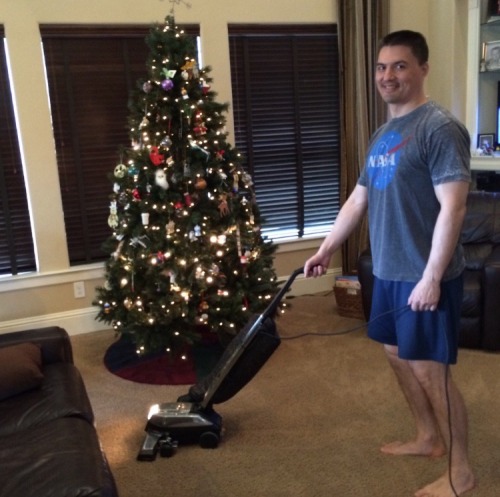
This is Kjell Lindgren. He’s a NASA astronaut who just got back from 5 months on the International Space Station. There are two reasons why this picture is hilarious:
His wife is flawless and makes bad space puns to make him do household chores.
I have that shirt. Thousands of people have that shirt. That shirt is available at Target. Which means actual astronaut Kjell Lindgren, with his wardrobe already full of NASA-issued and logo-emblazoned clothes, was at Target, saw a NASA shirt, and was like, “Yes, I am buying this because this is what I want to spend my actual astronaut salary on.”
tl;dr NASA employs a bunch of fucking nerds
The Beauty of Webb Telescope’s Mirrors
The James Webb Space Telescope’s gold-plated, beryllium mirrors are beautiful feats of engineering. From the 18 hexagonal primary mirror segments, to the perfectly circular secondary mirror, and even the slightly trapezoidal tertiary mirror and the intricate fine-steering mirror, each reflector went through a rigorous refinement process before it was ready to mount on the telescope. This flawless formation process was critical for Webb, which will use the mirrors to peer far back in time to capture the light from the first stars and galaxies.

The James Webb Space Telescope, or Webb, is our upcoming infrared space observatory, which will launch in 2019. It will spy the first luminous objects that formed in the universe and shed light on how galaxies evolve, how stars and planetary systems are born, and how life could form on other planets.
A polish and shine that would make your car jealous

All of the Webb telescope’s mirrors were polished to accuracies of approximately one millionth of an inch. The beryllium mirrors were polished at room temperature with slight imperfections, so as they change shape ever so slightly while cooling to their operating temperatures in space, they achieve their perfect shape for operations.

The Midas touch
Engineers used a process called vacuum vapor deposition to coat Webb’s mirrors with an ultra-thin layer of gold. Each mirror only required about 3 grams (about 0.11 ounces) of gold. It only took about a golf ball-sized amount of gold to paint the entire main mirror!

Before the deposition process began, engineers had to be absolutely sure the mirror surfaces were free from contaminants.

The engineers thoroughly wiped down each mirror, then checked it in low light conditions to ensure there was no residue on the surface.

Inside the vacuum deposition chamber, the tiny amount of gold is turned into a vapor and deposited to cover the entire surface of each mirror.

Primary, secondary, and tertiary mirrors, oh my!
Each of Webb’s primary mirror segments is hexagonally shaped. The entire 6.5-meter (21.3-foot) primary mirror is slightly curved (concave), so each approximately 1.3-meter (4.3-foot) piece has a slight curve to it.

Those curves repeat themselves among the segments, so there are only three different shapes — 6 of each type. In the image below, those different shapes are labeled as A, B, and C.

Webb’s perfectly circular secondary mirror captures light from the 18 primary mirror segments and relays those images to the telescope’s tertiary mirror.

The secondary mirror is convex, so the reflective surface bulges toward a light source. It looks much like a curved mirror that you see on the wall near the exit of a parking garage that lets motorists see around a corner.

Webb’s trapezoidal tertiary mirror captures light from the secondary mirror and relays it to the fine-steering mirror and science instruments. The tertiary mirror sits at the center of the telescope’s primary mirror. The tertiary mirror is the only fixed mirror in the system — all of the other mirrors align to it.

All of the mirrors working together will provide Webb with the most advanced infrared vision of any space observatory we’ve ever launched!
Who is the fairest of them all?
The beauty of Webb’s primary mirror was apparent as it rotated past a cleanroom observation window at our Goddard Space Flight Center in Greenbelt, Maryland. If you look closely in the reflection, you will see none other than James Webb Space Telescope senior project scientist and Nobel Laureate John Mather!

Learn more about the James Webb Space Telescope HERE, or follow the mission on Facebook, Twitter and Instagram.
Make sure to follow us on Tumblr for your regular dose of space: http://nasa.tumblr.com.
The United Launch Alliance’s Atlas V rocket carrying the Orbital ATK Cygnus module rolls to Cape Canaveral Air Force Station’s Launch Pad 41 in this time-lapse video. The rollout is in preparation for the Orbital ATK CRS-7 mission to deliver supplies to the International Space Station.
Launch is currently scheduled for 11:11 a.m. EDT, watch live coverage: http://www.nasa.gov/live
Make sure to follow us on Tumblr for your regular dose of space: http://nasa.tumblr.com
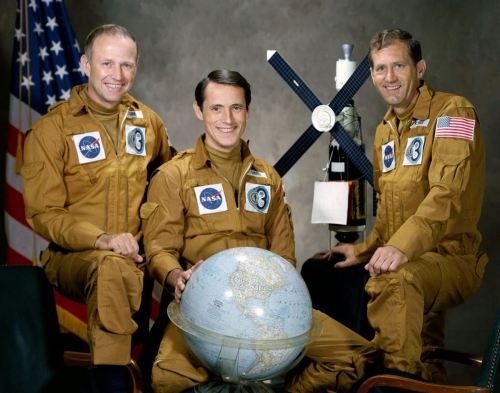

Happy Labor Day. Today I learned about probably the first strike to happen IN SPACE.

Stargazing is a difficult task, especially under adverse weather conditions, but human beings have also made it much harder for ourselves with all these pesky electrical lights and such. Light pollution affects vast swathes of inhabited land, but the introduction of Dark Sky Reserves helps to improve observational conditions for amateur and professional astronomers. Today, you get to hear more about Dark Sky Reserves as well as the Bortle Scale, which is used to judge the amount of light pollution affecting stargazing within an area.
Below the cut are my sources, music credits, a vocab list, and the transcript of this episode. Suggest what you think I should research next by messaging me here, tweeting at me at @HDandtheVoid, or asking me to my face if you know me. Please subscribe on iTunes, rate it and maybe review it, and tell friends if you think they’d like to hear it!
(My thoughts on the next episode are space race history, the transit of Venus, Shen Kuo, or Walter Baade. The next episode will be up on December 18th.)
Glossary
airglow - a very faint, bluish, naturally occurring glow that hangs around the horizon on Earth, usually within about 15 degrees of the horizon line.
Bortle Scale - an objective scale to measure the clarity and effect of light pollution on a night’s stargazing. Black and grey zones are the best for stargazing, blue is for rural skies, green and yellow are the rural/suburban transition zone, orange is the suburban sky, red is bright suburbia, and white is for cities and inner cities.
deep-sky object - any cosmological object that isn’t individual stars or something from our Solar System. It’s a classification that includes nebulae, galaxies, and star clusters, and it has its roots in amateur astronomy.
ecliptic - the path of the Sun across the sky over the course of a year.
gegenschein - a faint brightening in the night sky directly opposite the Sun. Astronomers think it’s caused by the reflection of sunlight off of dust ejected by comets or resulting from asteroid destruction.
light pollution - the excessive, misdirected, or intrusive use of artificial, human-made lighting. There are several major types of light pollution:
glare - when too-bright and poorly directed lights blind people.
light trespass - when neighboring lights are so bright that their light spills over and illuminates others’ property.
overillumination - when excessive lights are used in a small area.
skyglow - the visible glow caused by light scattering and reflecting off of the droplets of atmospheric molecules.
lumen - a measurement of a light’s brightness.
magnitude - the measurement of a star’s brightness as seen from Earth. The brighter it is, the lower its magnitude value. Ex. the Sun has an apparent magnitude of -27.
Messier object - a deep-sky object included on a list of 103-110 deep-sky objects made by Charles Messier and his colleagues in the 18th century in an attempt to prevent fuzzy, bright objects from being confused with comets.
zodiacal light - a faint brightening in the night sky along the ecliptic that results from sunlight scattered forward off dust in the direction of the Sun.
Transcript
Sources
Sodium lamp light pollution reduction effects via Flagstaff Dark Skies Coalition
Types of light pollution via the British Astronomical Association’s Campaign for Dark Skies, 2009
Light pollution via Sky and Telescope, Dec 2008
The World Atlas of Artificial Night Sky Brightness via the Light Pollution Science and Technology Institute
Lumens and watts via Lowes
UNESCO World Heritage Site list
Invention of the light bulb via SPS Industrial
Lightbulb components via CIO
Walter Baade bio via the Royal Astronomy Society of Canada
International Dark-Sky Association
“An IDA International Dark Sky Reserve is a public or private land possessing an exceptional or distinguished quality of starry nights and nocturnal environment that is specifically protected for its scientific, natural, educational, cultural, heritage and/or public enjoyment. Reserves consist of a core area meeting minimum criteria for sky quality and natural darkness, and a peripheral area that supports dark sky preservation in the core. Reserves are formed through a partnership of multiple land managers who have recognized the value of the natural nighttime environment through regulations and long-term planning.”
“The core area must provide an exceptional dark sky resource, relative to the communities and cities that surround it, where the night sky brightness is routinely equal to or darker than 20 magnitudes per square arc second.”
John Bortle’s article on his magnitude scale via Sky and Telescope, July 2006
“I have created a nine-level scale. It is based on nearly 50 years of observing experience. I hope it will prove both enlightening and useful to observers — though it may stun or even horrify some! Should it come into wide use, it would provide a consistent standard for comparing observations with light pollution.”
John E. Bortle receives the Leslie C. Peltier Award in 2013 via the Astronomical Society
Bortle dark sky scale via Big Sky Astronomy Club
Bortle dark sky scale via LSU
Gegenschein via Sky and Telescope, Oct 2015
Messier List via Fred Espenak’s website, Astropixels
Caldwell List via Students for the Exploration and Development of Space (SEDS)
Intro Music: ‘Better Times Will Come’ by No Luck Club off their album Prosperity
Filler Music: ‘New Son/Burnt Iron’ by Trampled by Turtles off their album Palomino
Outro Music: ‘Fields of Russia’ by Mutefish off their album On Draught
Ongoing Space Science Seeks to Keep Astronauts Healthy
ISS - Expedition 50 Mission patch. March 10, 2017 NASA is preparing for longer human journeys deeper into space and is exploring how to keep astronauts healthy and productive. The Expedition 50 crew members today studied space nutrition, measured their bodies and checked their eyes to learn how to adapt to living in space. The space residents also unloaded a cargo ship, worked on the Tranquility module and practiced an emergency simulation. The ongoing Energy experiment that ESA astronaut Thomas Pesquet collected urine samples for today seeks to define the energy requirements necessary to keep an astronaut successful during a space mission. Pesquet also joined NASA astronaut Peggy Whitson for body measurements to learn how microgravity affects body shape and impacts crew suit sizing. Commander Shane Kimbrough checked his eyes today with Whitson’s help and support from experts on the ground.
Image above: Astronaut Shane Kimbrough and Thomas Pesquet were pictured inside the cupola just after the SpaceX Dragon was captured Feb. 23, 2017. Image Credit: NASA. Kimbrough worked throughout the day before his eye checks and configured the Tranquility module for upcoming electronics and communications work. Cosmonaut Oleg Novitskiy continued unloading gear from the newly-arrived Progress 66 cargo ship. At the end of the day, Novitskiy joined Whitson and Pesquet for an emergency simulation with inputs from control centers in Houston and Moscow. Related links: Energy experiment: https://www.nasa.gov/mission_pages/station/research/experiments/397.html Body measurements: https://www.nasa.gov/mission_pages/station/research/experiments/1070.html Space Station Research and Technology: https://www.nasa.gov/mission_pages/station/research/index.html International Space Station (ISS): https://www.nasa.gov/mission_pages/station/main/index.html Image (mentioned), Text, Credits: NASA/Mark Garcia. Best regards, Orbiter.ch Full article
Voyager is so happy, because it’s the bravest satellite of all. It has gone the furthest. And it’s not lonely, because it’s talking to us. It phones home. And it tells us all about the wonderful things that it’s seeing. …There’s a whole universe to explore, and it’s just leaving our Solar System right now. It’s very brave and very lucky to be doing what it’s doing, so it’s not going to get lost. It’s traveled further than anything we’ve ever built has traveled before. It’s actually showing us the way. … It might have been safer for it to just stay home, and stay inside a building, but then it would have been sad forever, because it never would have done its purpose. It never would have discovered things. It’s all a wonderful story of great discovery and success, and it couldn’t have happened if Voyager hadn’t been brave… It’s not really the fact that everything always has a start and an end, it’s what happens in the middle that counts. What do you while you’re alive? What do you do while you’re laughing? And I think we’re doing exactly what makes Voyager joyful and as happy as it could be. Think about the fact that you’re a little bit like Voyager. In that you’re going to go see the world, and you’re going to call your mom on the phone and tell her about the wonderful things that you see. … You wouldn’t want to spend your whole life hiding under your bed and never seeing anything in your whole life, you want to be able to do what makes you happy and joyful and learn about things to discover. You might be the person that discovers something really important for everybody else on the world, but you can never discover that if you just hide and only do things that are safe. So think about yourself a little bit like Voyager. What makes you laugh? It’s not just staying, hiding underneath your bed safely at home.
Cmdr. Chris Hadfield, reassuring a five-year-old who was worried about the Voyager satellite (source)
oh no I’m having feelings about a satellite
tagging Doctor Who, because.
(via reconditarmonia)
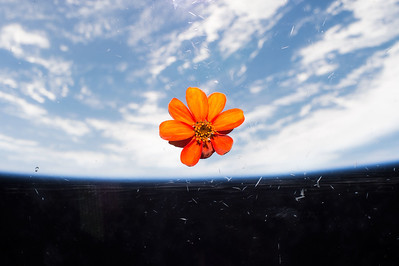
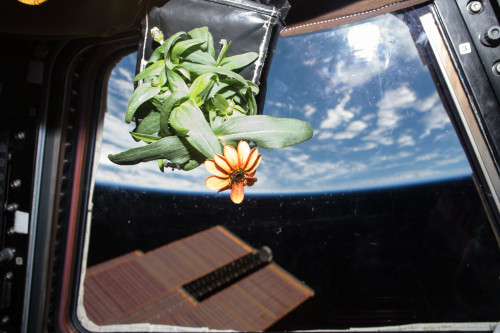
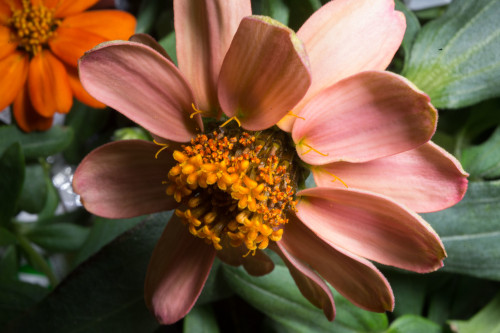
Take a moment, look outside your window. 🌷🌼
Today is the #FirstDayOfSpring in the Northern Hemisphere, also known as the vernal equinox.
#DYK Earth’s tilted axis causes the season? Throughout the year, different parts of Earth receive the Sun’s most direct rays. So, when the North Pole tilts toward the Sun, it’s summer in the Northern Hemisphere. And when the South Pole tilts toward the Sun, it’s winter in the Northern Hemisphere.
These images are of Zinnias. They are part of the flowering crop experiment that began aboard the International Space Station on Nov. 16, 2015, when NASA astronaut Kjell Lindgren activated the Veggie system and its rooting “pillows” containing zinnia seeds.
Make sure to follow us on Tumblr for your regular dose of space: http://nasa.tumblr.com.
-
 mintybunnies reblogged this · 8 years ago
mintybunnies reblogged this · 8 years ago -
 mintybunnies liked this · 8 years ago
mintybunnies liked this · 8 years ago -
 fillthevoid-with-space reblogged this · 8 years ago
fillthevoid-with-space reblogged this · 8 years ago -
 brenedec liked this · 8 years ago
brenedec liked this · 8 years ago -
 like-gossamer reblogged this · 8 years ago
like-gossamer reblogged this · 8 years ago -
 fillthevoid-with-space reblogged this · 8 years ago
fillthevoid-with-space reblogged this · 8 years ago
A podcast project to fill the space in my heart and my time that used to be filled with academic research. In 2018, that space gets filled with... MORE SPACE! Cheerfully researched, painstakingly edited, informal as hell, definitely worth everyone's time.
243 posts
